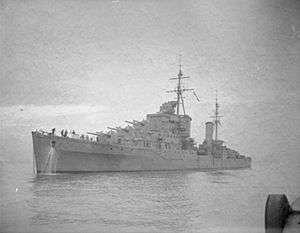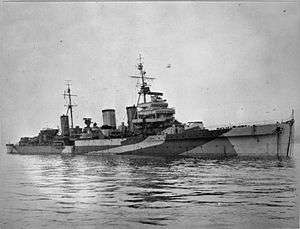Operation Fish
| Operation Fish | |||||
|---|---|---|---|---|---|
| Part of Second World War | |||||
 HMS Bonaventure was forced to remain stationary for a time to protect a treasure ship | |||||
| |||||
| Belligerents | |||||
|
|
| ||||
| Casualties and losses | |||||
| 0 ships sunk | |||||
Operation Fish was the World War II evacuation of British wealth from the UK to Canada. It was the biggest movement of wealth in history.[1]
Background
In September 1939 the British government decreed that all people living in the UK had to declare their securities with the Royal Treasury.[2] Even before Operation Fish convoys had been sent with millions of pounds' worth of gold and money to purchase weapons from the Americans. One such run involved Commodore Augustus Willington Shelton Agar and his ship HMS Emerald. At 23.18 on 3 October 1939 HMS Emerald dropped anchor in Plymouth, England. A short time later Agar was being briefed by Rear-Admiral Lancelot Holland on his mission. The written instructions are below.
Two million pounds in gold bars [UK£ 98,000,000 in 2016] is to be embarked in each ship to Halifax. A railway truck is expected to be placed alongside each ship about 01.00 October 7. Each truck is expected to contain 148 boxes each weighing 130 lbs. The total number of boxes is numbered Z 298 to Z 741 inclusive. Guards are to be put on each truck on arrival at the ship. Embarkation is to commence about 06.30 or as soon as daylight permits. Adequate steps are to be taken for supervision of each box from unloading from truck to stowage in ship. Finally a receipt is to be forwarded to C in C Western Approaches on the attached form.[3]
On 7 October 1939 Emerald sailed from Plymouth for Halifax, Nova Scotia with the gold bullion from the Bank of England, bound for Montreal, Canada, to be used to pay for American war materials. As this voyage was under the strictest secrecy, the crew were outfitted with "tropical white" uniforms, to confuse German agents. In the company of the two old battleships, HMS Revenge and HMS Resolution and her sister ship, HMS Enterprise, as well as the old cruiser HMS Caradoc, the Emerald ran into some of the heaviest seas that Agar encountered. By the time the convoy reached Halifax, the Emerald had lost her ship's boats, rafts, and various depth charges, wires, shackles, and other valuable equipment, not to mention her spotter plane, a Fairey Seafox.[3]

When Winston Churchill formed his government in 1940 the war was going badly for the Allies. As a guarantee that the Empire could continue the fight if the UK was overrun, Churchill devised a plan to ship British wealth to the safety of Canada.[4] Using their wartime powers the Churchill government confiscated the securities that the British people were forced to register at the beginning of the year and under the cover of secrecy moved them to the port of Greenock in Scotland. Then men sworn to silence loaded the wealth onto the Emerald-class light cruiser HMS Emerald. The ship departed on 24 June 1940 and with an escort of some destroyers sailed to Canada. Again another fierce storm almost ruined the operation when high seas forced the ships to slow their speed making them easy targets for any prowling U-Boats. When they finally reached Halifax, on 1 July 1940, the British treasure was transferred to trains and the gold sent to Ottawa while the securities were shipped to the Sun Life Building in Montreal.[4]
In another Operation Fish convoy on 5 July 1940 five ships loaded with $1.7 billion (US$ 28.76 billion in 2016), the largest movement of wealth in history.[1] Offshore they met their escort, which included the battleship HMS Revenge, a cruiser and several destroyers. Trouble arose when one of the convoy ships, a Polish ship, the Batory, loaded with treasure, had engine trouble and had to drop out of the convoy, escorted by only HMS Bonaventure. The two ships encountered heavy fog and because of the dangers of icebergs were forced to sit dead in the water, easy targets for any U-boats that might find them. Finally, after repairs were made, both ships were able to make it to Halifax days after the other treasure ships had landed.[1]

Storage
The British securities were locked in a specially constructed underground vault that was rushed into existence three stories beneath the Sun Life Building, and were guarded around the clock by the Royal Canadian Mounted Police. A persistent rumour that the Crown Jewels of the United Kingdom were stored there was deliberately spread in Montreal to account for increased activity at the building.[5] The extremely secretive United Kingdom Security Deposit, operating in the vault, arranged for the sale of Britain's negotiable securities on the New York Stock Exchange over the next few years to pay for Britain's war expenses. The 5,000 employees of Sun Life never suspected what was stored in their basement, and while unloading the treasure ships, not one crate of the cargo went missing. Even though thousands of people were involved, Axis intelligence agencies never found out about the operation.[6] Hundreds of accountants and bankers worked tirelessly to catalogue the contents of thousands of crates taken off the ships. When they were finished it was determined that $2.5 billion (US$ 28.76 billion in 2016) had been shipped from the UK to Canada without one ship being lost.[1]
In fiction
The 1993, BBC drama The Bullion Boys depicts the 1940 transport of Bank of England gold to Canada via Liverpool, and a plot by a group of Liverpool dock workers to steal some of it.[7]
Bibliography
- Notes
- 1 2 3 4 Breuer 2008, p. 62
- ↑ Breuer 2008, p. 60
- 1 2 Draper 1979, p. 37
- 1 2 Breuer 2008, p. 61
- ↑ Draper, pp. 255–257.
- ↑ Library and Archives Canada 2013
- ↑ The Bullion Boys at the Internet Movie Database
- References
- Breuer, William B. (2008). Top Secret Tales of World War II (2008 ed.). Book Sales. ISBN 9780785819516. - Total pages: 244
- Draper, Alfred (1979). Operation Fish: The Fight to Save the Gold of Britain, France and Norway from the Nazis (1979 ed.). General. ISBN 9780773600683. - Total pages: 377
- Library and Archives Canada (2013). "Hiding British Gold". Library and Archives Canada. Retrieved March 22, 2013.